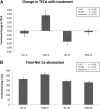Vitamin D supplementation and calcium absorption during caloric restriction: a randomized double-blind trial
- PMID: 23364004
- PMCID: PMC3578405
- DOI: 10.3945/ajcn.112.044909
Vitamin D supplementation and calcium absorption during caloric restriction: a randomized double-blind trial
Abstract
Background: Weight loss (WL) is associated with a decrease in calcium absorption and may be one mechanism that induces bone loss with weight reduction.
Objective: Because vitamin D supplementation has been shown to increase true fractional calcium absorption (TFCA), the goal of this study was to examine the effect of vitamin D during WL or weight maintenance (WM).
Design: A randomized, placebo-controlled, double-blind 6-wk study was conducted in 82 postmenopausal women [BMI (in kg/m(2); ±SD): 30.2 ± 3.7] with 25-hydroxyvitamin D [25(OH)D] concentrations <70 nmol/L during either WL or WM. All women were given 10 μg vitamin D(3)/d and 1.2 g Ca/d and either weekly vitamin D(3) (375 μg) or a placebo equivalent to 63 μg (2500 IU)/d and 10 μg (400 IU)/d, respectively. We measured TFCA with the use of dual-stable isotopes, 25(OH)D, parathyroid hormone, estradiol, calcitriol, and urinary calcium at baseline and 6 wk in weight loss and vitamin D(3)-supplementation (WL-D; n = 19), weight maintenance and vitamin D(3)-supplementation (WM-D; n = 20), weight loss and placebo (n = 22), and weight maintenance and placebo (n = 21) groups.
Results: WL groups lost 3.8 ± 1.1% of weight with no difference between vitamin D(3) supplementation and the placebo. The rise in serum 25(OH)D was greatest in the WL-D group (19.8 ± 14.5 nmol/L) compared with in WM-D (9.1 ± 10.3 nmol/L) and placebo groups (1.5 ± 10.9 nmol/L). TFCA increased with vitamin D(3) supplementation compared with placebo treatment (P < 0.01) and decreased during WL compared with WM. Serum 25(OH)D or 1,25-dihyroxyvitamin D did not correlate with TFCA.
Conclusion: These data show that vitamin D supplementation increases TFCA and that WL decreases TFCA and suggest that, when calcium intake is 1.2 g/d, either 10 or 63 μg vitamin D/d is sufficient to maintain the calcium balance. This trial was registered at clinicaltrials.gov as NCT00473031.
Figures


Similar articles
-
Supplementation with 1000 IU vitamin D/d leads to parathyroid hormone suppression, but not increased fractional calcium absorption, in 4-8-y-old children: a double-blind randomized controlled trial.Am J Clin Nutr. 2013 Jan;97(1):217-23. doi: 10.3945/ajcn.112.046102. Epub 2012 Nov 14. Am J Clin Nutr. 2013. PMID: 23151536 Free PMC article. Clinical Trial.
-
Weight loss and calcium intake influence calcium absorption in overweight postmenopausal women.Am J Clin Nutr. 2004 Jul;80(1):123-30. doi: 10.1093/ajcn/80.1.123. Am J Clin Nutr. 2004. PMID: 15213038 Free PMC article. Clinical Trial.
-
Hormonal and dietary influences on true fractional calcium absorption in women: role of obesity.Osteoporos Int. 2012 Nov;23(11):2607-14. doi: 10.1007/s00198-012-1901-5. Epub 2012 Jan 27. Osteoporos Int. 2012. PMID: 22282301 Free PMC article.
-
A randomized trial of vitamin D₃ supplementation in children: dose-response effects on vitamin D metabolites and calcium absorption.J Clin Endocrinol Metab. 2013 Dec;98(12):4816-25. doi: 10.1210/jc.2013-2728. Epub 2013 Oct 3. J Clin Endocrinol Metab. 2013. PMID: 24092833 Free PMC article. Clinical Trial.
-
Premenopausal overweight women do not lose bone during moderate weight loss with adequate or higher calcium intake.Am J Clin Nutr. 2007 Apr;85(4):972-80. doi: 10.1093/ajcn/85.4.972. Am J Clin Nutr. 2007. PMID: 17413095 Free PMC article. Clinical Trial.
Cited by
-
A mouse model of vitamin D insufficiency: is there a relationship between 25(OH) vitamin D levels and obesity?Nutr Metab (Lond). 2017 Mar 11;14:26. doi: 10.1186/s12986-017-0174-6. eCollection 2017. Nutr Metab (Lond). 2017. PMID: 28293271 Free PMC article.
-
Circulating zearalenone and its metabolites differ in women due to body mass index and food intake.Food Chem Toxicol. 2018 Jun;116(Pt B):227-232. doi: 10.1016/j.fct.2018.04.027. Epub 2018 Apr 17. Food Chem Toxicol. 2018. PMID: 29678722 Free PMC article.
-
Changes in Bone Mineral Density After Weight Loss Due to Metabolic Surgery or Lifestyle Intervention in Obese Patients.Obes Surg. 2021 Mar;31(3):1147-1157. doi: 10.1007/s11695-020-05095-x. Epub 2020 Nov 3. Obes Surg. 2021. PMID: 33145717
-
Optimal Serum 25(OH)D Level and Vitamin D Intake in Young Korean Women.Nutrients. 2022 Nov 16;14(22):4845. doi: 10.3390/nu14224845. Nutrients. 2022. PMID: 36432534 Free PMC article.
-
Calcium plus vitamin D supplementation and risk of fractures: an updated meta-analysis from the National Osteoporosis Foundation.Osteoporos Int. 2016 Jan;27(1):367-76. doi: 10.1007/s00198-015-3386-5. Epub 2015 Oct 28. Osteoporos Int. 2016. PMID: 26510847 Free PMC article.
References
-
- Norman AW. Intestinal calcium absorption: a vitamin D-hormone-mediated adaptive response. Am J Clin Nutr 1990;51:290–300 - PubMed
-
- Seamans KM, Cashman KD. Existing and potentially novel functional markers of vitamin D status: a systematic review. Am J Clin Nutr 2009;89:1997S–2008S - PubMed
-
- Heaney RP, Dowell MS, Hale CA, Bendich A. Calcium absorption varies within the reference range for serum 25-hydroxyvitamin D. J Am Coll Nutr 2003;22:142–6 - PubMed
-
- Barger-Lux MJ, Heaney RP. Calcium absorptive efficiency is positively related to body size. J Clin Endocrinol Metab 2005;90:5118–20 - PubMed
Publication types
MeSH terms
Substances
Associated data
Grants and funding
LinkOut - more resources
Full Text Sources
Other Literature Sources
Medical
Miscellaneous

